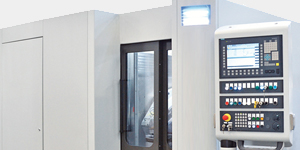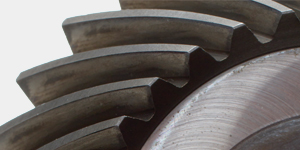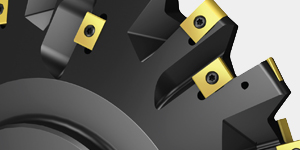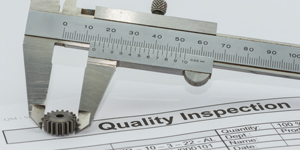The process of designing and creating gears is an astonishingly complicated process involving precise engineering and a lot of complex mathematics.
That’s why it’s important to have a company with experts that deals with the intricacies of gear geometry. And that expertise can be found at Oktoida, a Polish company that spun off from its parent company, Prozamet, in 2020.
“The company throughout its history has specialized in producing special gears — and I mean custom gears as opposed to catalog gears — with a high degree of difficulty in small- and medium-batch sizes,” said Dr.-Ing. Igor Zarebski, director of Oktoida. “At present, the company products include spur and helical cylindrical gears, straight and spiral bevel gears, hypoid, differential, epicyclic and worm gear sets, synchronizers and spline shafts.”
‘The special curve’
Oktoida, which is the Polish word for “octoid,” is a major clue as to how in depth the company’s gear design knowledge is, according to Zarebski.
“It means that we are pretty deep in gear geometry and gear mathematics, and we are able to analyze things like the octoid — which is the special curve — the line of action or the pressure line in bevel gears,” he said. “Furthermore, the cylindrical gears can be thought of as a special case of bevel gears, with outer cone distance approaching infinity. In this case, the octoid becomes a straight line, and we end up with an involute gear meshing. We have our own software developed for gear geometry calculations. Normally, I think it’s more common that a gear-making company buys some kind of ready solution and adopts it for its needs. But we have created all the software that we use for calculating gears in-house.”
Oktoida’s approach means the company maintains precise control over critical areas of its gear manufacture process, according to Zarebski.
“That means we are trying to do all the things that are very important for us and for our production in-house — one example would be the manufacture of tooling,” he said. “We manufacture the cutting tools, especially the most critical ones. And also, we manufacture the workholding components. We are pretty independent in this area.”

Big advantage
Being able to design and manufacture the tools used for gear production offers a tremendous advantage, according to Zarebski.
“When we started making our own tools, we found that we can experiment with coatings; we can experiment with materials, with hardness, and other different things,” he said. “We found that there is a lot of things to discover, and we can get more specialized, we can achieve better results when we have control over the tools.”
Being a gear manufacturer who’s able to design and create the tools that will be used to make the gears is something rather unique, according to Zarebski.
“Since we specialize in small- and medium-batch production, and we have these difficult gears, which are non-standard, custom, special gears for special requirements, it is a very important thing that we are able to do,” he said. “The lead time is now dramatically reduced, because we have pre-made blanks. Starting our own tool-making program has turned out to be very important and has given us an advantage.”

Taking care of its customers
Since Oktoida specializes in small- to medium-batch production, the company can maintain close contact with its customers, according to Zarebski.
“We are monitoring their needs and adjusting our manufacturing capabilities accordingly,” he said. “The expectations of our customers are always growing, so we introduce new machining technologies and implement new solutions in the process to meet their requirements. We maintain balanced development. That means we are responding to the real needs on the market.”
At any given time, Oktoida has about 200 different part numbers in production, according to Zarebski, and those parts are being designed and manufactured for a variety of different sectors, including construction, energy, food, shipbuilding, oil and gas, and mining.
“We do automotive gears — but not OEM; we do spare parts; we do parts for agriculture machines; we do printing; we do robotics; we do industrial machinery — so many kinds of gears, different markets,” he said. “This is a targeted approach to get more customers — to diversify our customer base.”

Challenges are a specialty
When it comes to difficult requests from its customers, Zarebski said that challenges are Oktoida’s specialty.
“We usually work with the customer until we complete the task that they set for us,” he said. “There are cases when this requires the creation of special calculation modules and the development of some dedicated tools, technology, and measuring solutions. There are cases where we developed a whole new technology for a given job for a single customer. But this is what we do. This is our specialty. We are also paying a lot of attention to details, like the internal metallurgical structure of the gears. We have experience with changing the key treatment parameters to achieve tailored processes for a given part and to minimize the heat treatment distortions, so we can use smaller finishing allowances, which can optimize production costs. We have found that many little details make the difference.”
Oktoida prides itself in working closely with its customers to successfully complete a project, according to Zarebski.
“We strive to have all the key competencies in-house,” he said. “That means that we are designing the tools, the workholding, and we are also manufacturing those in-house. We are calculating the geometry of the gears. We are calculating the tooling. When we have all these elements ready, we can manufacture the gears. And because we are creating computer models of the gears, we can use that for the coordinate measuring machines to check the gearing against the model and to correct any deviations. At the end, we get a closed loop, so we can watch our quality and be sure that we are manufacturing what has been designed at the beginning.”

The design of gear manufacturing process
Oktoida’s ability to design a gear manufacturing process from scratch is a skill Zarebski is particularly proud of.
“We have an ability to manufacture the gears from scratch,” he said. “This allows us to solve specific problems for customers. Today, many customers know that they can come to us with the most complex tasks, and they know that we’ll find a solution for them. We have developed our own in-house calculation programs for all manufactured types of gears. We’ve also developed our own in-house computer-aided manufacturing programs for the creation of gearing machining programs, which, as I mentioned, lets us design and make our key gear-cutting tools.”
To that end, Oktoida also makes excellent use of CNC technology, according to Zarebski.
“We only have a couple of conventional machines left,” he said. “We make use of the CMM (coordinate measuring machine) technology to inspect all types of gears that we are producing. And at the end, we are closing the feedback loop. We design, then we manufacture, then we check all the time. We have a very big influence on the geometry of the gear, because we are designing also the tools.”
Zarebski also emphasized Oktoida uses complex computer models of its production processes.
“This is very important, because it allows us to make precise project evaluations,” he said. “The pricing is very detailed and accurate. We can quickly change the input parameters, for example the batch size, and we can analyze the costs. It supports our investment decisions because we are able to monitor our performance, and to see which operations are cost-effective and which are not, and what should we improve. This translates into increasing our competitiveness on the market, but it also allows us to understand our strengths better and to achieve better quality at even better prices.”

Competitive production
With the vast expertise in Oktoida’s arsenal, the lead times on projects are quite competitive, according to Zarebski.
“It depends on the complexity of the project, but I would say if we started something new from scratch, it would take about 12 to 14 weeks,” he said. “If something has already been done here and we have all the tools and we have all the CNC programs and everything ready, then production time could get down to five to eight weeks.”
Team of experts
Oktoida’s ability to create precision gears accurately and efficiently from beginning to end wouldn’t be possible without the company’s expert team to make that a reality, according to Zarebski.
“Our most important resource is our people,” he said. “We are continuously investing in their development and improvement of their skills. This gives us the ability and the willingness to take on difficult tasks. We are optimizing our processes continuously in terms of efficiency and innovation. We also have a principle that we should tackle all challenges with an analytical and comprehensive approach, and that we should use the closed-loop philosophy, measuring what we are doing, making corrections, and repeating the process if necessary.”
As Oktoida continues to offer precision, custom-made gears for a multitude of sectors, Zarebski said it will be important for the company to stay adaptable and continue to control key areas of its production.
“This means being able to adapt the software that we have, modify the technologies, and develop new solutions when needed,” he said. “And also, we are using advanced economic optimization of our operations. Our feeling is that we’ll probably feed into the new requirements and continue to succeed in the market.”
MORE INFO oktoida.pl




























